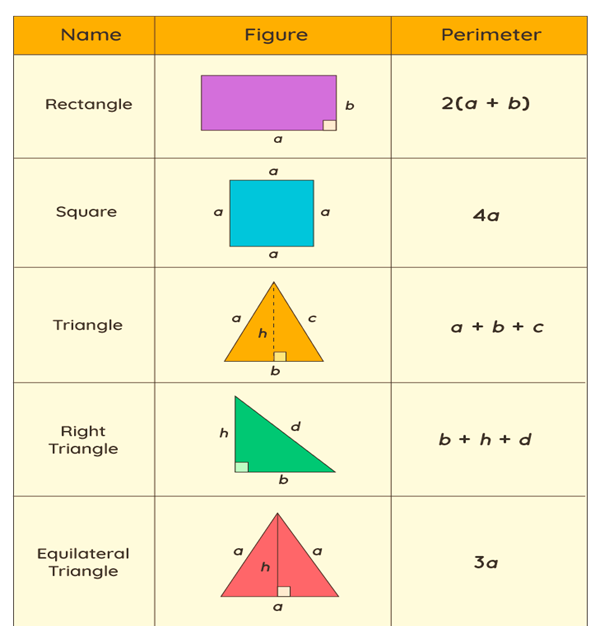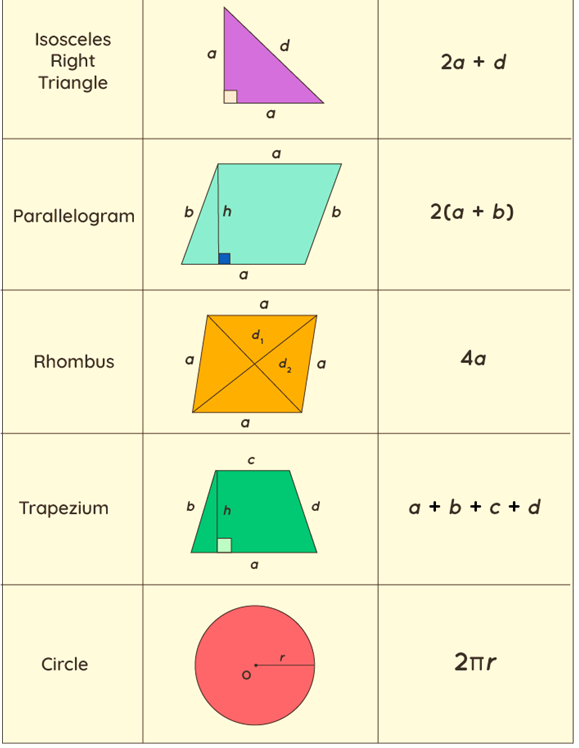About Perimeter Formulas
A shape's perimeter, also known as the outline, is the path or boundary that surrounds it. Different types of shapes are encountered in geometry, ranging from 2D to 3D shapes. The formulas for numerous 2-d shapes in geometry are covered by perimeter formulas. Let's go over the various formulas for different shapes and solve a few cases.
Meaning of Perimeter Formulas
By summing the side lengths of the 2-d shape, perimeter formulas are employed to calculate the distance around it. The total length of the sides of various shapes is referred to as the perimeter. If we know the shape's dimensions, we can calculate the perimeter formula. Depending on the shape of the item, each polygon has a distinct perimeter formula. The graphic below depicts all of the geometry formulas for various shapes.


Perimeter Formula of Different Shapes
The perimeter formula is the sum of all the sides of any geometric shape. The perimeter formula for various shapes in geometry varies based on the shape and size. Let's look at the formulas for these shapes' perimeters.
Perimeter Formula of a Square
Any geometric shape's perimeter is equal to the sum of its sides. In geometry, the perimeter formula for distinct shapes changes depending on their shape and size. Let's look at the perimeter calculations for these forms.
The perimeter of a Square
(P) = 4 × Side units
Perimeter Formula of a Rectangle
The perimeter formula for a rectangle is determined by the distance covered by the complete rectangle, i.e. the border or all four sides. 2l + 2b = 2(l+b) A rectangle's perimeter is equal to double the sum of its length and width. As a result, the formula for calculating the perimeter of a rectangle is:
The perimeter of a Rectangle
Where,
- l - length of the rectangle
- b - the breadth of the rectangle
Perimeter Formula of the Triangle
The perimeter formula for a triangle can be computed by adding all of the triangle's sides, in this example all three sides. For different sorts of triangles, different perimeter formulas are employed. However, the general formula for calculating a triangle's perimeter is:
The perimeter of a Triangle = Sum of all 3 sides
The perimeter formulas of different types of triangles are:
- Perimeter of the Scalene Triangle = a + b + c, where a, b, and c are the three different sides
- Perimeter of Isosceles Triangle = 2a + b, where a is the length of each of the two sides of equal length and b is the third side.
- Perimeter of Equilateral Triangle = 3 × a, where a is the length of each side of the triangle
- Perimeter of Right Triangle = p + b + h or p + b + √(p2 + b2), where h is the hypotenuse of a right triangle, p is perpendicular of a right triangle, and b is the base of a right triangle
- Perimeter of Right Isosceles Triangle = h + 2l, where h is height and l is the length
Perimeter Formula of a Parallelogram
The perimeter formula for a parallelogram is the sum of all sides that are equal to one another. However, if the sides of the object are not given but the diagonals or an angle are, the perimeter formula of a parallelogram can be obtained. As a result, the formula for calculating a parallelogram's perimeter is:
- Perimeter of Parallelogram (with sides), P = 2 (a + b), where a & b are the two adjacent sides
- Perimeter of Parallelogram (with one side and diagonals), P = 2a + √(2x2 + 2y2 - 4a2), where a is one side & x and y are the diagonals
- Perimeter of Parallelogram (with side, height, and angle), P = 2a + 2h / sin θ, where a is the side, h is the height, and θ is the angle
Perimeter Formula of the Circle
A circle's perimeter formula has two primary components: two constants and one radius of the circle. The perimeter of a circle is equal to its circumference, and the formula for calculating the perimeter or circumference of a circle is:
- Perimeter of a Circle = 2 π r
- = π d
Where,
- r - radius of the circle
- d - diameter of circle
- π(pi) - 3.412
Perimeter Formula of the Rhombus
A rhombus' perimeter formula is calculated by summing the lengths of all of the shape's sides. The formula for calculating perimeter of a rhombus has two parameters: when the sides are supplied and when the angles are given. As a result, the formula for calculating the perimeter of a rhombus is:
- Perimeter of a Rhombus (with sides), P = 4a, where a is the length of the sides
- Perimeter of a Rhombus (with angles), P = 2√(d1)2+(d2)2, where d1 and d2 are the lengths of the diagonals
Perimeter Formula of a Trapezoid
The perimeter of a trapezoid is calculated by adding the lengths of all four sides of the object. A trapezoid's perimeter formula ensures that it covers the whole boundary of the trapezoid. As a result, the formula for calculating a trapezoid's perimeter is:
Perimeter of a Trapezoid,
P = Sum of all sides = a + b + c + d,
where a, b, c, and d are the lengths of the sides
Perimeter Formula of a Kite
A kite's perimeter is measured by adding all of its sides, and the distance is derived by adding the sides of each pair. As a result, the formula for calculating a kite's perimeter is:
Perimeter of a Kite, P = 2(a+b),
where a and b are the lengths of the two pairs of kites
Perimeter Formula of Polygons
Because polygons are closed plane shapes, their perimeters are also in a two-dimensional plane. A polygon's perimeter formula can be calculated by measuring the polygon's total length. Polygon perimeters are determined in two ways: with respect to regular polygons and with respect to irregular polygons. The perimeter of a regular polygon is calculated using the following formula:
Regular Polygons:
- Perimeter of a Hexagon = 6 × (length of one side)
- Perimeter of a Pentagon = 5 × (length of one side)
Irregular Polygons:
Perimeter of Irregular Polygons = Sum of all sides
Get a List of Maths Formulas on one page